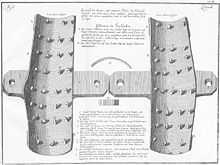- Boot (torture)
-
This article is about the boot as a torture device. For other uses, see Boot (disambiguation).
The boot was an instrument of torture and interrogation designed to crush the foot and leg. The boot has taken many forms in various places and times. Common varieties include the Spanish boot and the Malay boot. One type was made of four pieces of narrow wooden board nailed together. The boards were measured to fit the victim's leg. Once the leg was enclosed, wedges would be hammered between the boards, creating pressure. The pressure would be increased until the victim confessed or lost consciousness.
Contents
Spanish boot
The Spanish boot was an iron casing for the leg and foot. Wood or iron wedges were hammered in between the casing and the victim's flesh. A similar device, commonly referred to as a shin crusher, squeezed the calf between two curved iron plates, studded with spikes, teeth, and knobs, to fracture the tibia and fibula.[1]
Primitive forerunners of the archetype can be found dating back as far as a thousand years. The first Scottish effort—also referred to as a buskin—made use of a vaguely boot-shaped rawhide garment that was soaked with water, drawn over the foot and lower leg, and bound in place with cords. The contraption was slowly heated over a gentle fire, drastically contracting the rawhide and squeezing the foot until the bones were dislocated, though there would not have been sufficient pressure actually to crush the bones of the foot. A more progressive variant, found in both the British Isles and France, consisted of a trio of upright wooden boards that splinted around and between the feet and were tied in place by cords. Wedges were hammered between the boards and the feet to dislocate and crush the bones. A prototype hailing from Autun, France, consisted of high boots of spongy, porous leather that were drawn over the feet and legs. Boiling water was poured over the boots, eventually soaking through the leather and eating the flesh away from the entrapped limbs. Lastly, oversized boots of iron or copper (often soldered in place on the floor) received the prisoner's bare feet as he lay helplessly bound and gagged in a chair. The boots were slowly filled with boiling water or oil, or even molten lead, to consume the feet and legs. One variant—applied in Ireland to the martyr Dermot O'Hurley—consisted of lightweight metal boots that were filled with cool water and heated with the feet inside over a fire until the water boiled aggressively.
Foot press and Malay boot
The construction of the foot press, also known as the foot screw, was based upon the thumbscrew but was much heavier and stronger. The device consisted of a pair of horizontal iron plates, interconnected by a crank mechanism, wide enough to completely enclose the naked foot. As questions were put to the prisoner, the foot press was slowly tightened, squeezing the foot between the plates with sufficient pressure to fracture the arch and, ultimately, pulverize the toe bones. While it was quite standard to line the lower plate with ribs to prevent the bare foot from popping out of the grip of the instrument as it became sweatier, a crueler variant of this device—typically encountered in Nuremberg, Germany—lined the upper plate with hundreds of sharp spikes. A version from Venice even connected the crank mechanism to a drill, so that a hole was drilled in the center of the instep while the instrument was tightened. This family of torture devices is not widely recorded but is described in Richard Sair's The Book of Torture and Executions (Toronto: Golden Books, 1944), cataloged under the editor's name (Arnold Hirsch, M.D.) in the Library of Congress database (catalog number HV8593).
The Malay Boot is a foot press made of wood. One sees a "Hollywoodized" version of the Malay boot in the film China Seas, applied to Clark Gable—wearing socks, curiously—to force him to disclose the location of the ship's cargo of gold bullion.
References in literature and the cinema
- In Mikhail Bulgakov's masterpiece, The Master and Margarita, Signora Tofana, a guest at Satan's Ball, arrives wearing a Spanish boot on her left leg.
- The Malay boot features in a scene from the 1935 film China Seas.
- In Victor Hugo's novel The Hunchback of Notre Dame, the character of Esmeralda is tortured using the boot. In the 1939 movie version starring Charles Laughton and Maureen O'Hara as Esmeralda, the boot resembles dissociated planks with spikes scattered here and there; we do not see the device actually fitted over Esmeralda's foot. In the 1956 movie version starring Anthony Quinn and Gina Lollobrigida as Esmeralda, the boot is an ornate boot-shaped device of metal into which the front of Esmeralda's foot is inserted.
- In the premiere episode of the History Channel's program Surviving History, the Scarefactory design team builds and tests a recreation of the boot.
- Ken Russell's The Devils shows the priest Urbain Grandier being tortured with a form of the boot.
- The Spanish boot is used to extract confessions from those accused of witchcraft in 1970 Czech film Witches' Hunt (Kladivo na carodejnice).
- In Christensen's 1922 Swedish film Häxan (lit., The Witch), a boot-like torture is suggested by the juxtaposition of a generalized crusher—a rough stone that can be screwed down toward a metal base plate—to a young lady's naked foot.
References
- ^ McCall, Andrew: "The Medieval Underworld". Hamish Hamilton, 1979. ISBN 978-0-7509-3727-6
Categories:- Medieval instruments of torture
- Modern instruments of torture
- European instruments of torture
Wikimedia Foundation. 2010.



